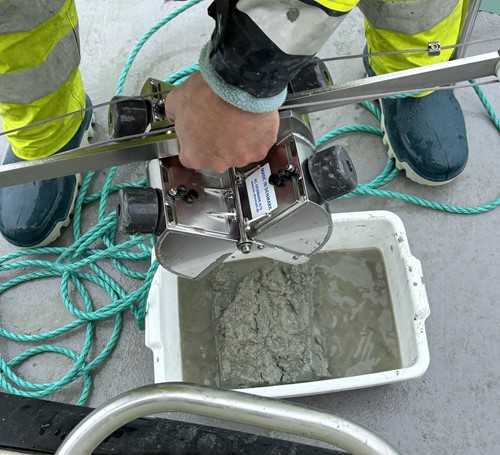Project
Greenlandic mud holds immense fertilisation and carbon capture potential

Project
Mud in the Greenlandic fjords, so-called glacial rock flour, has the ability to act as fertiliser for crops in depleted soils and store large amounts of CO2. Work is underway to commercialise the process, and NIRAS assists with the environmental permitting.
At the bottom of the Ilulialik fjord in south-western Greenland lie vast quantities of so-called glacial flour. Rock that over thousands of years has been pulverised into fine-grained siltstone by the Greenland ice sheet and continuously washes with the meltwater from the ice to the fjord, where it is deposited as mud.
For several years, Minik Rosing, a renowned geology professor at the University of Copenhagen, has studied this fine-grained material and has recently proven that glacial rock flour is extremely rich in minerals and nutrients, making it suitable for fertilising various crops - especially on depleted soils in tropical and subtropical countries. Results from Kenya show a 30 % increase in crop yields.
Not only that, Rosing and his research team have also shown that glacial rock flour is capable of capturing large amounts of CO2 from the atmosphere. Thus, this naturally occurring resource has the potential to both reduce CO2 emissions, while also being beneficial for food production globally.
That is why Minik Rosing is spearheading the startup Rock Flour Company, which wants to set up collection of glacial rock flour for export and utilisation in relevant parts of the world. The Ilulialik fjord is the first collection site where NIRAS, based on its in-depth knowledge of Greenland, has started the initial environmental baseline studies – first phase of the project permitting procedure.
“This is an innovative first-mover project, where the underlying philosophy of potentially both storing CO2 and raising the standard of living for many people in the developing world is something we are of course very proud to be involved with, and which aligns extremely well with our overall ambition to assist and facilitate sustainability and GREENsition.”
Anders Isak Stig-Jørgensen, Environment Market Director, Greenland at NIRAS.

The actual collection of the glacial rock flour is carried out from the water, using a light, mobile setup. Such an operation does potentially have an impact on the marine environment, and this is one of the environmental aspects that Anders Isak Stig-Jørgensen and his colleagues are studying.
“Overall, the project has an appealing, simple setup in terms of environmental impact. Compared to traditional mining projects that require heavy, energy-intensive machinery and blasting on land, this operation is a simple and relatively energy efficient setup. Furthermore, glacial rock flour does not require intensive processing to be usable once it has been collected.
“The collection of glacial flour deviates from the typical mining operation as nature has done the bulk of the processing for us. This is a constant, natural resource that continuously flows into the fjord and settles. Moreover, in this one fjord, there is so much glacial rock flour that you can cover a huge demand for many, many years to come,” he says.

“The potential of this material is huge, and apart from the many application areas we are looking at, there’s plenty more avenues left to explore. Being a team deeply driven by bringing solutions to the world, it's an incredible feeling to build a company with the potential to have not just one, but three major impacts - on climate, agriculture, and communities.”
Eliot Booth, COO, Rock Flour Company.
The way in which glacial rock flour can store CO2 is called enhanced weathering. Weathering is the process that occurs when CO2 dissolves in water and forms carbonic acid, which can dissolve rocks. This happens in nature, and can be seen, for example, when old statues slowly crumble over time. Enhanced weathering involves spreading crushed rock, in this case glacial rock flour, over a larger area to speed up the natural process that allows CO2 to be reduced in the atmosphere.
What is special about the glacial rock flour in Greenland is that it has been mechanically crushed in a cold climate and therefore has not weathered and is still rich in mineral nutrients. If used in tropical and subtropical areas, it will be able to revitalise the nutrient-poor soil.
In a study by Minik Rosing and his colleagues, they estimate that if glacial flour was spread on all fields in Denmark, it would be possible to capture 27 million tonnes of CO2 - or the equivalent of total annual CO2 emissions in Denmark. However, it should be pointed out that this is calculated on the assumption that the environmental conditions are similar to those in the study. In addition, the time frame for the absorption of CO2 is still unknown.
The experiment was discontinued after just three years, so the researchers have most likely only seen the tip of the iceberg.
Rock Flour Company is already looking at other potential application fields. Recently, the company received a major governmental grant.
